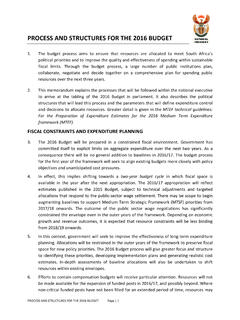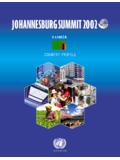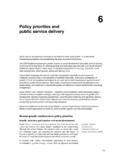Transcription of CHAPTER 5 APPROACHES TO BUDGET REFORM - World Bank
1 75 CHAPTER 5 APPROACHES TO BUDGET REFORMC hapter 1 suggests that APPROACHES to budgeting, resource allocation, and financialmanagement are constantly changing to reflect which of the three functions of budgeting is inthe ascendancy - control of public resources, planning for the future allocation of resources, or management of resources. A key message was that REFORM efforts usually failed becausethey were incomplete. CHAPTER 2 reformulated these three functions into three levels ofbudgetary outcome: aggregate fiscal discipline, strategic prioritization and efficient andeffective service delivery. This is the basis of a conceptual framework for thinking about whatconstitutes an effective system of Public Expenditure Management (PEM).
2 Chapters 3 and 4provide guidance on key components of a PEM system. This CHAPTER discusses approachesto, and sequencing of, original concern of control - to ensure that taxes were spent in accordance with thewishes of Parliament - has since been supplemented by a concern to control aggregateexpenditure for macroeconomic stability. CHAPTER 1 notes that more recent REFORM effortsincorporate improved APPROACHES to allocation and management of resources. Chapters 2, 3,and 4 point out that budgetary reforms of recent years can develop systems and processesthat simultaneously improve performance of all three functions and CHAPTER builds on the proposition that REFORM efforts fail not only because they areincomplete, but also because they are often designed to solve a technical problem when theproblem lies in the institutional framework.
3 The next step is to confront the fact that it is oftendifficult to generate enthusiasm for budgetary REFORM , notably among politicians. Thehandbook argues for engaging all potential beneficiaries in REFORM efforts; for putting the focuson performance; and for defining performance broadly, , in terms of the three levels. Withthis broader definition of budgetary performance, constituencies with an interest in a well-performing BUDGET have a vehicle for pushing for many countries have been distracted and too many scarce resources wasted bythe latest budgetary tool or technique. Specific tools and techniques do have a contribution tomake, and they are prominent in most current REFORM efforts. However, they cannot solve theproblem of a BUDGET system and process that is not performance oriented and that does nothave the basics AND ISSUES IN BUDGET REFORMThe best examples of current REFORM efforts represent a substantial departure from pastefforts.
4 The new wave recognizes the key weaknesses of past REFORM efforts, in particular thefailure to address the relationship between control and performance and the incentives forperformance in the full range of formal and informal budgeting, decision making, andmanagement rules (restraints and flexibilities). Just as BUDGET REFORM cannot by itself be thesole driver of improved performance - the BUDGET is embedded in the decision making andmanagement practices of government - neither will performance improve sustainably in anenvironment where the BUDGET system gets in the way of the broader REFORM lessons about the what and how of BUDGET REFORM can be derived from theexperience of over 100 years of REFORM across the full spectrum of countries.
5 They are is important to consider at the outset the deficiencies of the particular BUDGET system. In what sense is it performing below expectations? the basic functions of budgeting - control of public resources, planning for thefuture allocation of resources, management of public resources - BUDGET systemsinvolve many subfunctions, all of which influence the three levels of budgetaryoutcome. These subfunctions include policy making, conflict resolution,communicating, accounting, macroeconomic direction, program selection, evaluation,and aid management. A REFORM program may address one or more of these issues, butit must take account of the linkages between all of them. Particular dimensions systems cannot be bought fully assembled off the shelf.
6 They areprocesses that continue to develop, not solutions for all time. They are alsosystems linked to other systems, particularly political and managerial. If thesesystems are deficient, it is unlikely that the BUDGET systems will deliver soundbudget outcomes, particularly at levels 2 and basics have to be understood. BUDGET systems include a wide rangeof basic supporting services, including accounting, BUDGET examination,estimating, forecasting, monitoring, and evaluating. If these components arenot adequate, the BUDGET system is unlikely to perform well. Poor performanceoccurs when budgets do not come out in time to influence events, containunrealistic assumptions, are made and remade throughout the year (implicitly orexplicitly), contain flagrant opportunities for corruption, or are simply circumstances require patient diagnosis, detailed analysis of how moneysare released, spent and accounted for, restructuring of organizations, institutionbuilding, and careful consideration of objectives and methods.
7 The fault willmore often lie not with the basic BUDGET systems themselves, but with theenvironment in which they systems face certain intrinsic problems, including: the relationship between macro and micro levels; the balance between long- and medium-term commitments and flexibilityto meet exigencies; differences in outlook between BUDGET personnel and program andplanning staffs related to background, values and systems are communication systems, conveying signals about behavior,prices, priorities, intentions, and commitments. BUDGET reforms should takeparticular account of effective communication, a two-way process that facilitates77bringing the full range of stakeholders into the REFORM process. Particularattention needs to be paid to donor foreign aid is significant, particular attention needs to be paid to aligningdonor practices with the REFORM effort.
8 As a minimum, all donor support togovernment should be incorporated in the reforms do not implement themselves. A detailed implementation strategyneeds to be built into their design, but it must build in flexibility to learn and adapt. Noknown REFORM effort has specified at the outset all the elements of the ultimate systems, however capable, are not self-contained. In particular, they areadversely affected by multiple, converging uncertainties, political instability, vulnerableregimes, wars, entrenched patterns of expenditure, donors, severe inflation, andstructural imbalances between expectations and resources. The BUDGET system mustbe built to cope with these realities, but be aware of self-inflicted uncertainties orrigidities (including those associated with donor practices).
9 The information base to aid decision making is a crucial ingredient of REFORM ,but incorporating more analysis into budgetary decision making does not automaticallylead to better decisions. Apart from the problems of quantifying and measuringperformance, such information rarely leads to a single clear policy choice. Policychoice is essentially political, and strengthening decision making requires a recognitionof the multitude of factors that bear on a greater performance orientation into a BUDGET system is not simply a matterof implementing the latest tool or technique. Excessive expectations are often raisedabout the capacity of these tools and techniques to contribute to, even replace, centralresource allocation decisions.
10 Such costs and techniques are much more likely tocontribute to improvement in resource use at the line agency level. In the end,performance-oriented tools and techniques will only deliver where the central processesof resource allocation, budgeting, and financial management change to support andrequire a performance orientation at the agency level. Equally important are personnelmanagement and structure of government that provide incentives for REFORM is not a choice between leaving the unreformed system in place oradopting a new budgeting approach lock, stock and barrel. Many of the concepts ofzero-based, performance, or program budgeting can be incorporated slowly into atraditional budgeting system.

















